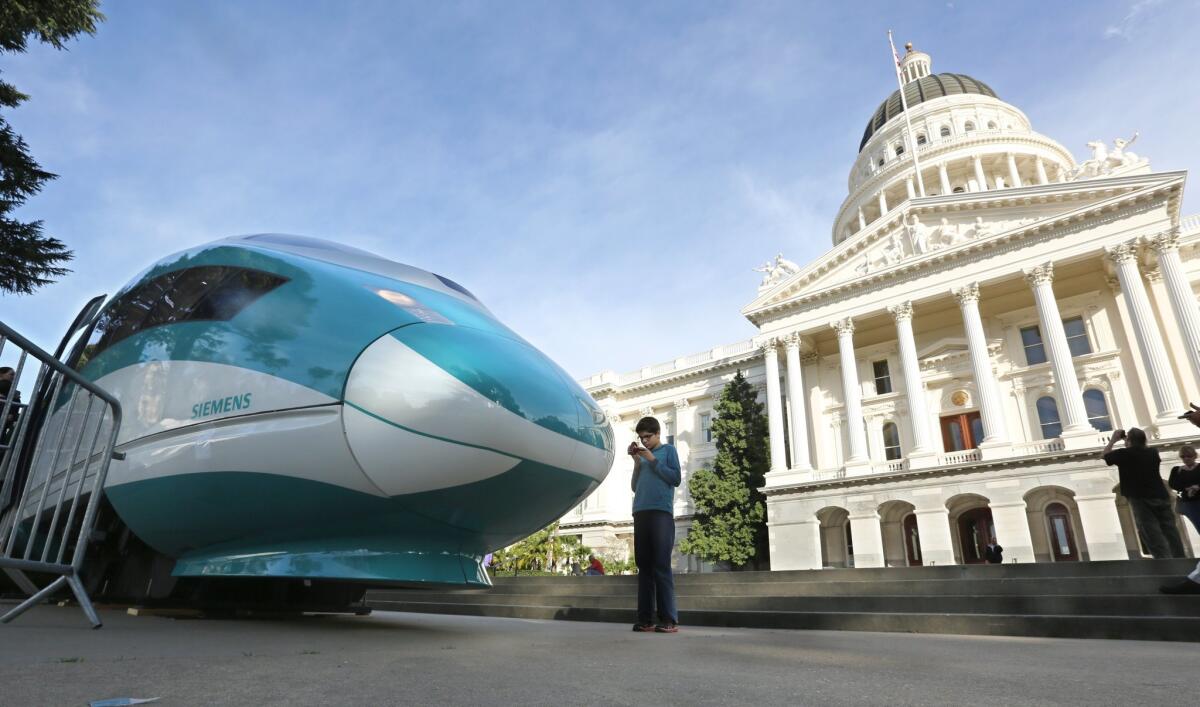Editorial: Red flags for high-speed rail

A full-scale mock-up of a high-speed train is displayed at the Capitol in Sacramento.
- Share via
Did the California High-Speed Rail Authority downplay potential cost increases for the state’s controversial bullet train? In a draft PowerPoint presentation dated October 2013, the agency’s project management consultant estimated that the cost of the first phase of the line, from Burbank to Merced, could grow to about $36 billion. Yet the authority ended up putting a lower cost estimate in its official business plan released four months later, The Times recently reported.
The authority had rejected The Times’ request under the California Public Records Act for a copy of the presentation. Only this week, after lawmakers called on Assembly Speaker Toni Atkins (D-San Diego) to subpoena the report, did the authority release the 22-page document.
True, the presentation was labeled a draft. And authority officials said they used “scores of analyses and assessments” to develop the updated cost estimates. Still, it’s worrisome that the staff was given a detailed report on increasing costs from the project management contractor, and yet that information is missing from the 2014 business plan the authority presented to lawmakers and the public. The agency says it chose the more optimistic estimates because it’s confident that it can keep the costs down, an ability we won’t be able to measure until the project is well underway.
This should raise red flags for the Legislature and Gov. Jerry Brown. California is pouring considerably more money into building the bullet train than voters anticipated in 2008 when they approved $10 billion in bonds for a high-speed rail line from Los Angeles to San Francisco. Since then, the official price tag has increased from $33 billion to $68 billion. To help cover the cost, Brown and the Legislature agreed to chip in 25% of annual cap-and-trade revenue, which amounted to $250 million this year and could generate as much as $1 billion annually.
This page has long supported the train project because of its potential to provide an environmentally friendly way to handle the increasing travel between Los Angeles and San Francisco, to integrate Central Valley communities more tightly into those two cities and their economies, and to maintain the state’s position as a technology leader. With the rail line now under construction in the San Joaquin Valley, however, lawmakers should be asking hard questions to make sure the project can live up to that potential without breaking the bank.
Is the rail authority being frank and transparent with the public about the costs of the project? Can the project attract private investors to fill the gap between the government’s contributions and the total bill? Yes, the first construction contracts have come in under budget — that’s good news. Now, can those contracts stay within budget? These are fair and important questions, especially when the public has already seen the price of the rail line double since 2008 and the scope of the project scaled back.
Follow the Opinion section on Twitter @latimesopinion and Facebook
More to Read
A cure for the common opinion
Get thought-provoking perspectives with our weekly newsletter.
You may occasionally receive promotional content from the Los Angeles Times.






